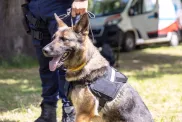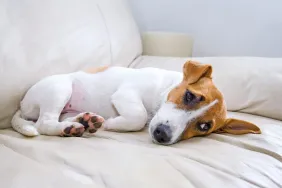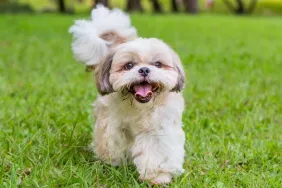Within each of our four-legged friends lies a naturally gifted athlete. Even the tiniest Chihuahua or pudgiest Persian possesses amazing physical abilities. Unfortunately, too many of our pets have been benched, resulting in an epidemic of obesity rivaling that of Americans. In fact, about 44 percent of dogs are overweight or obese and 57 percent of cats are too heavy. When pets gain weight, they increase their risk of arthritis, diabetes, high blood pressure, cancer, and behavioral problems. To help keep your pet—and you—trim, try these tips for squeezing in a little exercise and fun every day.
Indoor games
1. High and low. This game is like squats for your dog or cat. With a kibble or piece of food in one hand, have your pet lie down or sit. For dogs, lower the treat and coax your dog to jump up and follow it. Then quickly lower the reward again and return the dog to a sitting or lying position. An ideal “high and low” is when your dog explodes upward and immediately lays down again. Repeat this three to five times before giving the food.
For cats, place their food on a counter or table (add a pinch of tuna or salmon for extra incentive) and have the cat jump up to get it. Return the bowl to the floor and repeat several times.
2. Hide and seek. This is similar to fetch but without the throwing—and resulting broken lamps. Show your dog a favorite toy. Lead your dog into another room while you hide the toy from your dog’s view. Make the hiding place obvious at first, like the toy peeking out from under a pillow. You may have to help your dog find the toy the first couple of tries. When your dog finds the toy, praise and give a kibble or piece of food. Hide the toy in progressively more challenging places as the game continues. This game is so fun you won’t need food after a couple of rounds.
3. Find the food. Cats are natural predators. To tap into the instinct and encourage your cat to get its move on, try dividing the food into small bowls placed throughout your house. Have your cat watch as you “hide” the bowls. Your cat will “hunt” the food throughout the day. This is one of the best ways to get corpulent cats on their feet and burning calories.
4. Follow the leader. This classic indoor game uses the same skills as “come and get it” below. Show your dog or cat a favorite toy and call her to you. Walk around your house with your pet following you. Go as fast as you like; just don’t blame your pet for any broken items.
5. Obstacle course. Set up an indoor obstacle course made of empty drawers, buckets, pillows, boxes, or broomsticks. Have your dog jump, crawl, and navigate around furniture and objects for an intellectually stimulating activity. Playtime is about togetherness, not the quality of your toys. Get creative and resourceful to make even the dullest day bright with love and excitement.
6. Remote-controlled toys. Technology has provided pet owners an almost endless supply of remote-controlled toys. Many dogs and cats will chase a remote-controlled car or interactive talking toy. Look for a pet-friendly toy or car that has few small parts and is durable enough to withstand a paw strike or bite. Don’t scold your pet if it destroys the toy; fun happens.
Outdoor games
1. Fetch. One of the most entertaining activities for many dogs is fetch. Use a fun toy and start with baby throws. Get your dog’s attention and throw the ball or toy a couple of feet away. When he reaches the toy, praise him. As soon as he puts the toy in his mouth, take a few steps away while calling him to you. As your dog begins to approach, continue offering praise. When he reaches you, give the command “release” and show him a treat. Most dogs will trade the toy for a goody. Repeat this sequence, each time throwing the toy a little farther and stop giving treats after two or three trips.
2. Come and get it. Show your dog a favorite toy, such as a ball or Frisbee. As you do this, quickly bend over at the waist and extend your arms downward. This nonverbal communication cue signals you want to play. While you’re bending over, say, “Come and get it!” As soon as you’re certain you have your dog’s attention, turn and run away. When your dog gets within three or four feet, stop and offer praise and a tiny treat. If your dog isn’t interested in chasing you, don’t chase the dog because doing so may teach that it’s a game to run from you.
3. Obstacle course. Set up a basic agility or obstacle course in your yard. My favorite fun fitness device is a climbing obstacle or ramp. Walking up and down uses your dog’s largest muscle masses in the rear legs. Weaving poles and jumping bars are also great ways to make exercise fun. While all of these tools can be bought online or a pet store, you can easily make your own with a little ingenuity. Ramps can be as simple as wood raised on blocks and weaving poles can be made from dowels or broomsticks. Dogs want to learn new skills, just like people do. Teaching old dogs new tricks might not only help them lose weight but also stay mentally healthy.
4. Stair mutts and hill hounds. A simple technique for healthy, overweight dogs is to find a hilly trail or flight of stairs and walk up and down. (Before you walk your dog on stairs or hills, ask your veterinarian to evaluate your dog’s knees and hips. Obese dogs can put more stress on their joints, resulting in higher frequency of injuries.) Maintain a moderate pace and avoid sharp turns or jumps. Five to 10 minutes of solid hill or stair climbing is a great workout for any pudgy pooch. If you have stairs in your home, feed your cat in places that make her go up or down them.
5. Swimming. If your dog likes to swim, indulge. Many breeds, such as Retrievers, seem hard-wired to dive right in. For dogs with joint injuries or arthritis, swimming is an excellent exercise option. For many cats, swimming (bathing or water in general) is often less than enjoyable.
Exercising your pet can be as basic as shaking a piece of yarn or as complex as an agility-course competition. Find an activity that suits both you and your pet and do it consistently. Add new routes, games, and toys on a regular basis. While exercise certainly won’t replace feeding fewer calories when it comes to your dog or cat losing weight, it is a vital part of a healthy lifestyle for both pets and people. When you and your pet move together, you celebrate one of the oldest, most unique, and most extraordinary bonds our planet has ever known.
Sections of this article were excerpted from Dr. Ward’s book, Chow Hounds-Why America’s Dogs Are Getting Fatter: A Vet’s Plan to Save Their Lives (HCI Publications, March 2010)

Dr. Ward is president of the Association for Pet Obesity Prevention and the chief of staff at Seaside Animal Care in Calabash, N.C.









